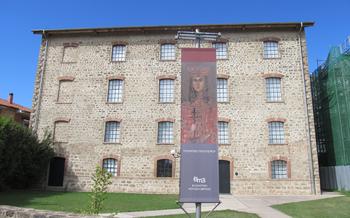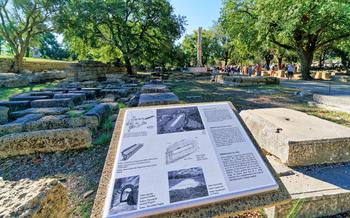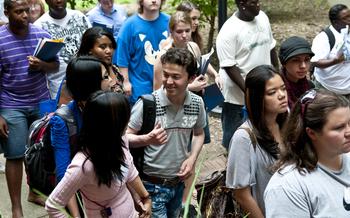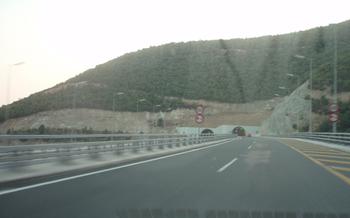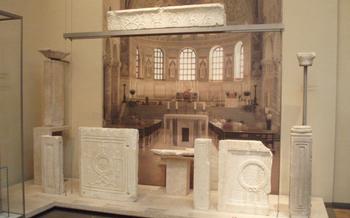
The Monastery of Osios David
- The Monastery of Osios David: A Timeless Sanctuary
- A Journey Through Time: History of the Monastery
- Architectural Masterpiece: Exploring the Monastery
- In the Footsteps of Osios David: A Spiritual Retreat
- Unveiling the Mosaics: A Visual Feast
- Frescoes that Speak: A Narrative in Color
- Exploring the Grounds: A Serene Landscape
- The Church of Osios David: A Sacred Space
- The Refectory: A Place of Nurturance
- The Scriptorium: Where Words Come to Life
- The Museum: Preserving the Past
- Events and Festivals: A Celebration of Faith
- Insider Tip: Plan Your Visit
The Monastery of Osios David: A Timeless Sanctuary
Perched on a hilltop overlooking the serene landscapes of Veria, the Monastery of Osios David stands as a testament to the enduring power of faith, art, and history. This sacred sanctuary, with its profound spiritual allure and architectural splendor, has captivated pilgrims and travelers for centuries.
The monastery boasts a rich historical tapestry, dating back to the Byzantine era, when it was founded by the venerable Osios David. According to legend, Osios David, a pious hermit, sought refuge in a cave on this very site, attracting followers who sought his spiritual guidance. As his fame spread, a community of monks formed around him, and the monastery was established.
Over the centuries, the monastery has undergone several renovations and expansions, blending Byzantine, Ottoman, and modern architectural influences into a harmonious ensemble. Its majestic domes, intricate mosaics, and graceful arches showcase the artistry and devotion of its builders.
Nestled amidst the picturesque surroundings of Veria, the Monastery of Osios David is easily accessible by road. Its proximity to other historical and cultural attractions makes it an ideal destination for those seeking a journey of faith, history, and architectural exploration.
A Journey Through Time: History of the Monastery
The Monastery of Osios David, steeped in the annals of time, traces its origins to the Byzantine era. In the early 6th century, the pious monk David, seeking a life of solitude and communion with the divine, chose this secluded spot to establish his humble abode. His reputation for sanctity and wisdom soon attracted a growing community of disciples, leading to the foundation of the monastery.
The monastery flourished under the patronage of Byzantine emperors and wealthy benefactors, becoming a renowned center of learning and spirituality. Throughout the centuries, it faced challenges and tribulations, including invasions and occupations. However, it persevered, thanks to the unwavering dedication of its monastic community and the enduring legacy of Osios David.
In the 16th century, the monastery underwent a comprehensive renovation and expansion, resulting in the architectural splendor we witness today. The monks continued to play a vital role in preserving and transmitting knowledge, operating a renowned scriptorium where manuscripts were meticulously copied and illuminated.
Today, the Monastery of Osios David stands as a testament to the enduring spirit of Byzantine monasticism, a place where history, faith, and art converge to create a timeless sanctuary.
Architectural Masterpiece: Exploring the Monastery
The Monastery of Osios David stands as a testament to the architectural brilliance of the Byzantine era. Its design seamlessly blends form and function, creating a harmonious and awe-inspiring space. The monastery's exteriors captivate with their intricate brickwork and stone carvings, while the interiors unfold a symphony of domes, arches, and vaults that soar towards the heavens.
Adorned with vibrant mosaics and frescoes, the monastery's walls become a canvas for storytelling, depicting biblical scenes, saints, and intricate geometric patterns. Each mosaic and fresco bears witness to the skill and artistry of the craftsmen who painstakingly brought them to life. The harmony of colors, shapes, and textures creates a visual feast that transports visitors to a realm of beauty and devotion.
Beyond its aesthetic appeal, the monastery's architecture also reflects its functional purpose. The layout of the buildings, courtyards, and chambers reveals a deep understanding of monastic life and the needs of its inhabitants. From the refectory, where monks gathered for communal meals, to the scriptorium, where they diligently copied and illuminated manuscripts, every space is designed to foster a sense of community, contemplation, and spiritual growth.
Exploring the architectural wonders of the Monastery of Osios David is a journey through time, where the past and present intertwine to create a sacred space of beauty, harmony, and devotion.
In the Footsteps of Osios David: A Spiritual Retreat
Osios David, a renowned ascetic and teacher, lived in the 6th century AD. According to legend, he was a shepherd who heard a voice telling him to abandon his flock and seek a life of solitude in the mountains of Veria. There, he built a small chapel and devoted his life to prayer and contemplation. His reputation for holiness and wisdom spread, attracting disciples and pilgrims who sought his guidance.
The monastery became a center of spiritual learning and a place of refuge for those seeking a deeper connection with God. Osios David's teachings emphasized humility, compassion, and the importance of a pure heart. He encouraged his followers to lead a simple and virtuous life, free from worldly attachments.
To this day, the Monastery of Osios David remains a place of pilgrimage for Orthodox Christians who come to pay homage to the saint and seek his intercession. The monastery's serene atmosphere and rich spiritual history provide a sanctuary for reflection, prayer, and inner peace.
Unveiling the Mosaics: A Visual Feast
The Monastery of Osios David is renowned for its exquisite Byzantine mosaics, which adorn the walls and ceilings with a kaleidoscope of colors and intricate designs. These mosaics depict biblical scenes, saints, and symbolic motifs, creating a visually stunning and awe-inspiring atmosphere.
The artistry and craftsmanship of the mosaics are evident in the meticulous attention to detail and the vibrant hues that seem to come alive under the soft light that filters through the windows. The mosaics tell a story, inviting visitors to explore the rich tapestry of Byzantine iconography and delve into the religious and cultural significance of each scene.
One of the most striking mosaics is the depiction of the Virgin Mary enthroned with the infant Jesus, surrounded by angels and saints. The expressions on their faces convey a sense of serenity and devotion, capturing the essence of Byzantine spirituality. Another notable mosaic portrays the life of Osios David, showcasing key moments from his journey as a monk and his spiritual teachings.
These mosaics are not merely decorative elements; they serve as a visual representation of the monastery's history, beliefs, and traditions. They offer a glimpse into the minds and hearts of the monks who created them, expressing their faith and devotion through art.
As visitors wander through the monastery, they are surrounded by these stunning mosaics, which transport them back in time and offer a unique perspective on the vibrant artistic and spiritual heritage of Byzantium.
Frescoes that Speak: A Narrative in Color
The walls of the Monastery of Osios David are adorned with vibrant frescoes, each a masterpiece of Byzantine art. These frescoes are not mere decorations; they are a narrative in color, telling stories from the Bible, the lives of saints, and the history of the monastery.
The frescoes are arranged in a systematic manner, guiding the viewer through a visual journey of faith and spirituality. They depict scenes from the Old and New Testaments, such as the Creation, the Annunciation, the Crucifixion, and the Resurrection. Each scene is rendered with great detail and emotion, capturing the essence of the story it portrays.
In addition to biblical scenes, the frescoes also depict the lives of saints and martyrs, particularly those associated with the monastery. Among them is Osios David himself, whose life and teachings are illustrated in a series of frescoes that trace his journey from a humble shepherd to a renowned ascetic and spiritual guide.
The frescoes at the Monastery of Osios David are not only visually stunning but also deeply meaningful. They serve as a reminder of the rich spiritual heritage of the monastery and its enduring legacy as a center of faith and devotion.
Exploring the Grounds: A Serene Landscape
Beyond the architectural marvels, the Monastery of Osios David also boasts a serene and picturesque landscape. Visitors are greeted by lush gardens, tranquil courtyards, and verdant olive groves that create a tranquil and inviting atmosphere. The courtyards, adorned with colorful flowers and aromatic herbs, offer a peaceful retreat for contemplation and reflection. The olive groves, a symbol of the region's rich agricultural heritage, stretch out in rows, providing a sense of tranquility and serenity. Take a leisurely stroll through the grounds, allowing the beauty of nature to soothe your soul and transport you to a realm of tranquility.
The Church of Osios David: A Sacred Space
At the heart of the Monastery of Osios David stands its namesake church, a testament to the spiritual devotion and architectural prowess of Byzantine artisans. This sacred space invites visitors to immerse themselves in an atmosphere of tranquility and awe.
The church's intricate architecture captivates the eye with its intricate stonework, graceful arches, and soaring domes. Its interior is adorned with stunning mosaics and frescoes that depict biblical scenes and the life of Osios David, inviting visitors to contemplate the spiritual journey of this revered saint.
Ornately carved iconostasis, a traditional Byzantine feature, separates the sanctuary from the nave, creating a sense of mystery and reverence. Within the sanctuary, the altar, adorned with intricate carvings and precious objects, serves as a focal point for religious rituals and ceremonies.
The Church of Osios David is not merely a historical artifact; it remains an active place of worship, where the monks and pilgrims gather for prayers, ceremonies, and spiritual contemplation. The church's enduring significance as a sacred space is a testament to the enduring legacy of Osios David and the enduring power of faith.
The Refectory: A Place of Nurturance
The refectory, or dining hall, of the Monastery of Osios David is a place of both sustenance and fellowship. Here, the monks gather daily to share meals and strengthen their communal bonds. The refectory is a reminder of the importance of community and the shared experience of monastic life.
The refectory is a simple yet elegant space, with long wooden tables and benches arranged in rows. The walls are adorned with religious iconography, including a large fresco of the Last Supper. This fresco serves as a reminder of the importance of sharing and community, as well as the spiritual nourishment that is provided by the Eucharist.
The meals served in the refectory are simple and vegetarian, in keeping with the monastic tradition of austerity. However, they are prepared with care and are often quite delicious. The monks grow many of their own vegetables and fruits in the monastery gardens, and they also raise their own chickens and goats. As a result, the food is fresh and flavorful.
The refectory is more than just a place to eat. It is also a place for the monks to come together and share stories, laughter, and support. It is a place where they can relax and recharge, both physically and spiritually. The refectory is a vital part of the monastic community, and it plays an important role in the daily life of the monks.
The Scriptorium: Where Words Come to Life
Within the walls of the Monastery of Osios David, a hidden gem awaits discovery. The scriptorium, a sanctuary of knowledge and devotion, was the beating heart of the monastery's intellectual pursuits. Here, skilled monks meticulously copied and illuminated manuscripts, perpetuating the written word and preserving ancient wisdom.
The art of calligraphy flourished within these sacred walls. Monks, guided by patience and precision, transformed parchment into masterpieces. Their deft hands danced across the pages, creating intricate letters and embellishments that adorned the texts. Each stroke carried the weight of history and tradition, ensuring that knowledge would endure for generations to come.
Beyond mere transcription, the scriptorium was a hub of creativity and scholarship. Monks engaged in the profound task of exegesis, delving into the depths of religious texts to unravel their hidden meanings. They composed commentaries and treatises, expanding the body of knowledge and fueling intellectual discourse within the monastic community.
The legacy of the scriptorium extends far beyond the monastery's walls. Through the dissemination of manuscripts, the teachings of Osios David and other revered figures spread throughout the Byzantine Empire and beyond. Monasteries across the region eagerly sought copies of these precious texts, fostering a vibrant exchange of ideas and contributing to the intellectual and spiritual growth of the entire Christian world.
Today, the scriptorium stands as a testament to the enduring power of the written word. Its legacy of scholarship and devotion continues to inspire, reminding us of the transformative power of knowledge and the unwavering dedication of those who dedicated their lives to preserving it.
The Museum: Preserving the Past
The Monastery of Osios David houses a treasure trove of artifacts and relics that offer a glimpse into its rich history and spiritual significance. The museum, located within the monastery complex, showcases a diverse collection of ecclesiastical objects, vestments, and icons that have been carefully preserved and restored. These artifacts provide tangible evidence of the monastery's centuries-old traditions and the devotion of its inhabitants.
Visitors to the museum can admire intricately designed vestments, adorned with gold embroidery and vibrant colors, which were worn by monks and priests during religious ceremonies. The collection also includes an array of icons, each depicting a different saint or biblical scene with exquisite detail and craftsmanship. These icons, which were often used for prayer and contemplation, offer a unique perspective into the spiritual lives of the monks and the beliefs that guided their daily existence.
Through its collection of artifacts, the museum at the Monastery of Osios David serves as a bridge between the past and the present, allowing visitors to connect with the rich heritage and spiritual traditions of this sacred site. It is a place where history comes alive, and visitors can gain a deeper understanding of the enduring legacy of the monastery and its role in shaping the cultural and religious identity of Veria and the surrounding region.
Events and Festivals: A Celebration of Faith
The Monastery of Osios David comes alive during its annual festivals and celebrations, offering visitors a chance to immerse themselves in the vibrant spiritual culture of the region. The most significant event is the feast day of Osios David, celebrated on November 26th. During this time, the monastery hosts grand religious processions, special services, and traditional ceremonies. Pilgrims from near and far gather to pay homage to the saint and seek his blessings. Other festivals throughout the year celebrate various religious holidays and saints' days, each with its own unique traditions and customs. These events provide an opportunity to witness the deep devotion and rich cultural heritage of the monastery and the surrounding community.
Insider Tip: Plan Your Visit
To fully appreciate the splendor of the Monastery of Osios David, plan your visit carefully. The best time to visit is during the spring or fall, when the weather is pleasant and the crowds are smaller. Remember to dress modestly, covering your shoulders and knees out of respect for the religious nature of the site. Guided tours are available, providing valuable insights into the history and significance of the monastery. However, if you prefer to explore at your own pace, self-guided tours are also an option. Take advantage of the opportunity to combine your visit with other attractions in Veria, such as the Archaeological Museum or the Byzantine Museum. By planning ahead, you can create a truly memorable and enriching experience at the Monastery of Osios David.
